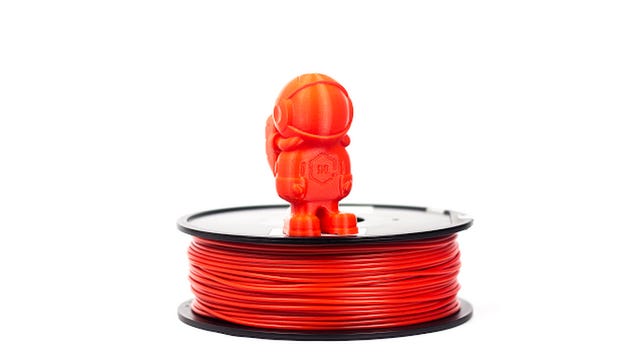Technologies
Start Your Project Off Right With the Best 3D Printing Filament in 2022
There are a lot of different 3D-printing materials out there. Here’s how to pick the right one for your project.

You’ve got the best 3D printer you can buy, but without materials, you can’t get printing. If you chose a fused deposition modeling, or FDM, printer — the most common type of 3D printer for hobbyists — you’ll need a few rolls of special plastic. The material we use for FDM 3D printing is called filament and it’s an easy material to pick up. There are, however, different types of filament, each good for certain projects and terrible for others. You’ll want to make sure you’re using the best filament for the job at hand, or it may fail.
I’ve put together this primer of the different types of filament as well as choices of the best filaments from my favorite brands. This will be updated regularly and contains some great choices for you to start.
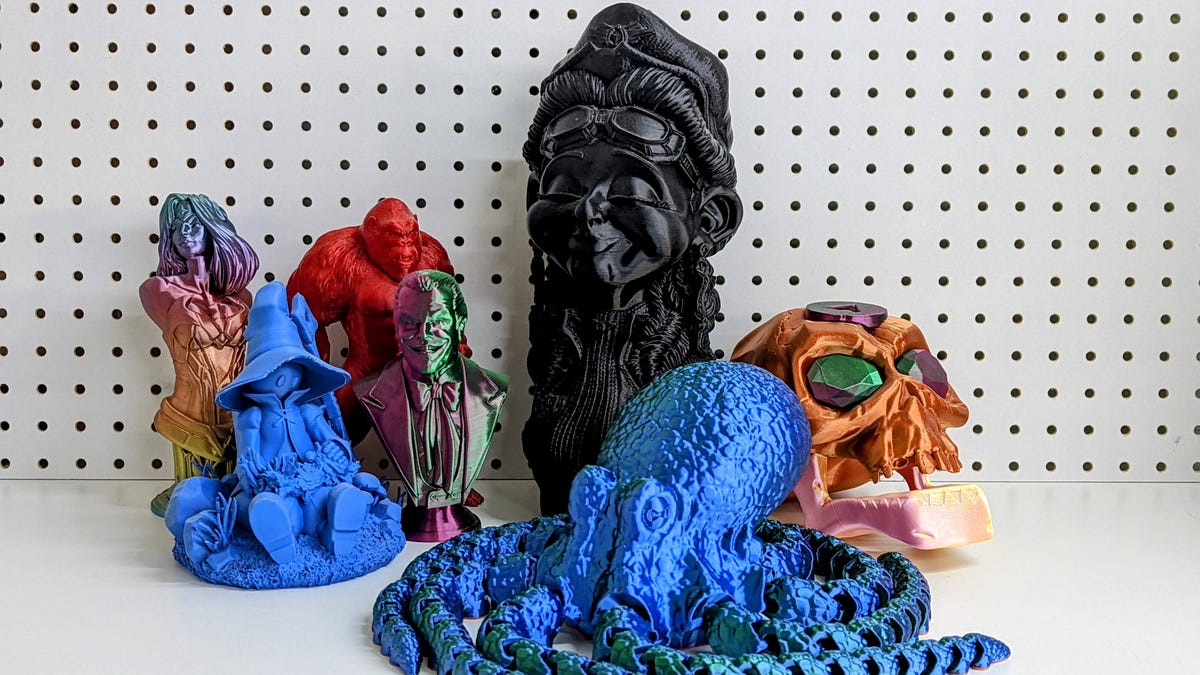

It’s important to choose both the right type of material and the right brand of that type, be it PLA, ABS or something more exotic. Here are the best of each of the five main filament types.
Read more: Best 3D Printers
Those categories are:
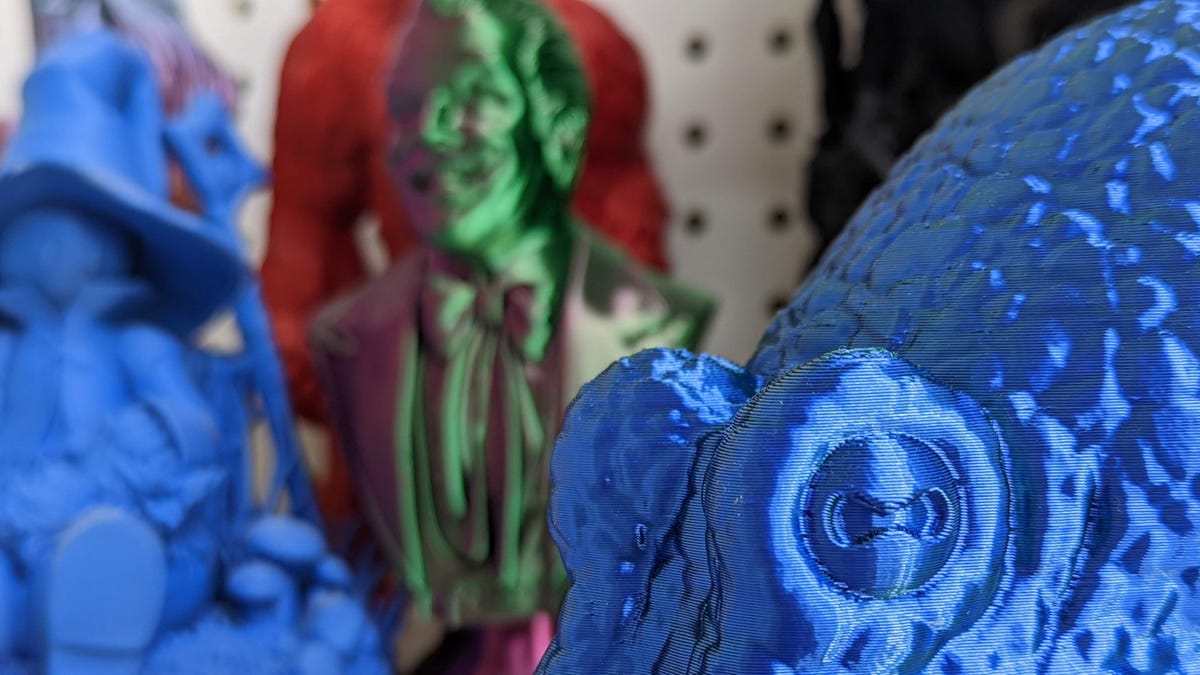

PLA is the easiest material to use to make awesome things.
James Bricknell/CNETPolylactic acid
Polylactic acid, or PLA, is the most common 3D printing filament and the easiest to use. Unlike most plastics, it’s made from corn starches so it is non-toxic and, in theory, compostable, though it takes an industrial composter to do it. PLA uses a fairly low heat — between 190 and 215 degrees Celsius (or between 374 and 419 degrees Fahrenheit) — to melt the plastic for extrusion so it is the safest of the filaments. Almost every FDM 3D printer in the world can print PLA.
PLA pros
- Nontoxic
- No awful smell
- Easy to use for a beginner
- Almost universally usable on any FDM printer
- Very cheap
PLA cons
- Can require a lot of sanding
- Can easily warp in the sun or high-temp environments
- Can be brittle
MatterHackers
Build PLA from MatterHackers is great for projects that require finishing (sanding, painting and so on). I have about 12 rolls of it in my workshop, and use it for large projects, including my Mandalorian armor or cosplay swords. The dimensional accuracy — how consistent the diameter is along the length of the roll — is good, though nothing mind-blowing. It’s well within the sweet zone.
Post-processing is where Build Series PLA shines. It is simple to sand and holds paint well, as long as you use a good primer and filler first. Like all PLA, it holds together well using superglue and even takes putty and Bondo without complaint.
Flashforge
The color of this PLA is hard to describe, but it is beautiful. It has a purple-blue-green hue to it and looks like metal that’s been heated up a lot. Right now it’s probably my favorite-looking filament on my shelf.
It’s also easy to print with, and because of the shifting colors it hides layer lines well. If you’re looking for a dark filament that you aren’t painting over, I’d pick up a few rolls of this today.
MatterHackers
For something completely different in the PLA world, check out Quantum by MatterHackers. Transitional filament, mixing multiple colors, has been around for a while, but it normally changes color across the length of the material. This causes it to change color as it goes further up the model.
Quantum is actually two colors fused across the entire width, so you get an amazing transition from left to right. It’s absolutely mesmerizing, and I love using it for all sorts of different projects. From vases to giant articulated octopuses, it makes any model look breathtaking.
Cookiecad
I have been meaning to buy some of this beautiful filament for some time now, and I’m really happy I did. The color is almost exactly the same as Mint choc chip ice cream and the tiny flecks of marble color enhance the look even more. It prints great, with a nice glossy finish, and I found printing it at a higher temperature brings out that gloss really well.
More importantly than the print quality though, I love it for the way it makes me feel. The color just makes me happy and reminds me of days at the beach with my kids. It’s gorgeous.
Sunlu
Sunlu is one of those filaments that is really easy to get hold of and prints well every time you use it. It says its dimensional accuracy is +/- 0.02mm, but I’ve been lucky to never have the variance above 0.01mm in hands-on use.
Sunlu also comes in some beautiful matte colors, which is a welcome break from more common shiny filaments. Sanding and printing with it is easy. If you’re new to 3D printing and need to increase your collection of PLA, this is a cheap way to do it.
James Bricknell/CNET
Rainbow filament tends to transition between colors very slowly. This means you often get only one or two colors per model. Creality’s latest rainbow filament has a much shorter transition, so you get a much nicer rainbow effect across your models. It looks great on this amazing dragon from Fotis Mint.
Polymaker
For projects you can show off without having to paint them first, PolyTerra might be for you. The colors are vivid, and because they are matte, you don’t lose details in the reflections like with shiny filament.
PolyTerra also comes in recycled cardboard reels, and the creator, Polymaker, will plant a tree in the area where the roll was bought to help offset the cardboard used. This filament is still plastic of course, but it helps my conscience to use it.
Ataraxia Art
In this article about this flexible PLA I explained how, although this isn’t technically PLA, it does print much easier than TPU, a more common flexible filament. I used it to print an amazing Mandalorian Blacksmith helmet for my 4-year-old. She can’t break it because it’s so bouncy.
This isn’t for newbies, though. It took a lot of trial and error to get the setting for my 3D printer right, and because it is so soft the accuracy can be pretty wonky. But for something that’s different from normal PLA, it is worth checking out.
Acrylonitrile butadiene styrene
ABS was one of the more 3D printing filaments a few years back, and it still has some excellent uses. The biggest downside is the toxicity. You don’t want to breathe in ABS as it melts, so you’ll need a well-ventilated area. That aside, it’s sturdier and more heat-resistant than PLA. Most printers can print ABS, but you’ll need a heated bed that can reach 100 degrees Celsius for best results and protecting your printing job in an enclosed printer is a good idea.
ABS pros
- Can withstand a lot of heat
- Easy to sand
- Can be smoothed with acetone for a perfect shine
ABS cons
- Its fumes are toxic so it requires ventilation
- It needs far more heat to print than PLA
- You will need an enclosure to get good results
Inland
Inland makes good filament across the board and its ABS is no different. I’ve never had issues with the dimensions, and the final product has consistent layer lines. Sanding Inland ABS is a joy as the material can be wet-sanded to a smooth finish.
MatterHackers
Fillamentum is one of my favorite ABS makers. The colors are always so vibrant, and while it costs a little more than the competition, it keeps that vibrancy even after the model is finished printing. If you’re looking for ABS that you don’t need to paint, Fillamentum is a great place to start.
Polyethylene terephthalate glycol
PETG is chemically similar to the plastic that water and soft drink bottles are made of, and is a great alternative to ABS. It has the heat-resistant properties of ABS without the toxic fumes and can be sanded much like PLA. Most FDM printers that can print PLA can print PETG, though it takes a little more effort to get right.
PETG pros
- Easier to print than ABS
- Holds a finish well
- Easier to store than other filaments
PETG cons
- Requires high temps, which can damage printer parts over time.
Protomaker
This USA-made PETG has an excellent glassy look that is hard to achieve in melted plastic. The aqua color is subtle and gives the appearance of a stained glass window when printed at the high end of its temperature scale.
Printing with it was easy, though the roll is a little big for printers like the Bambu Lab X1, that has enclosed filament system.
Matterhackers
The Pro series filament from MatterHackers is a much nicer product than a lot of standard PETG. Yes, it costs a little more, but it’s designed to help reduce some of the issues that filament suffers from. It reduces shrinkage, so the part you make is as close to the part you designed as possible. This is a great material for those who make 3D printed models for a living, rather than a hobby.
Overture
Overture PETG is a favorite because it comes in an economical two-pack, making it ideal for multiple or larger jobs. I’ve used a lot of Overture products, including PETG and PLA, and they always print well. I once printed an 11-foot-long Masamune sword using Overture and it came out looking awesome.
Thermoplastic polyurethane
TPU is a flexible material that can make cool rubbery models. Most people use it to 3D print phone cases, but more serious modelers often use it to create connectors or flexible hinges to other materials. It can be a difficult material to work with and is best used on a direct-drive 3D printer such as the Prusa Mk3s, rather than a Bowden printer like the Anycubic Vyper. A direct drive printer places the gears to move the filament directly on the print head, while a Bowden setup has them on the frame of the printer.
TPU pros
- Flexible
- Won’t warp in the heat
- Available in fun colors
TPU cons
- Terrible for making solid prints
- Hard to work with on budget printers
MatterHackers
MatterHackers Build Series Materials sit in the perfect balance between usability and cost. Yes, I’ve had failures with the Build Series, but once you get it dialed into your printer, you can make dozens of fun, springy models.
I like to use it to make fun toys for my kid’s preschool as they can be thrown around with no fear of breaking into small, sharp pieces.
Exotic filaments
Exotic filaments are ones that are outside the normal five choices, or interesting variations on those choices. They’re often PLA mixed with carbon fiber or glow-in-the-dark chemicals and something that prints outside the normal parameters of a 3D printer. You’ll often need to upgrade your printer nozzle to use these. It’s advanced stuff, but I wanted to show you my favorite glow-in-the-dark filament, which is fun to print with.
Amolen PLA
Glow-in-the-dark filament normally comes in a standard «radioactive» green, but this beautiful roll transitions through multiple colors. It’s simply gorgeous.
It’s also worthwhile to buy some replacement brass nozzles for your printer as glow-in-the-dark filament can chew them up pretty quickly because the glowing material is more abrasive than standard colors.
Filament FAQ
What filament should I start with?
If you’re buying a printer for the first time, the best choice of filament is PLA. It is the easiest to print with, the safest in terms of fumes and the most readily available. Think about laying in a store of PLA when you first start. A 1-kilogram roll feels like a lot, but once you get the itch, materials get eaten up quickly.
Are there different sizes of filament?
Yes. There are two main thicknesses of filament and if you get them mixed up, your machine won’t print.
1.75mm filament is the most common. It’s been adopted by most of the 3D manufacturers in the world and if you have an entry-level printer, it’s likely to run on 1.75mm filament.
Some 3D printers still use the thicker 3mm style, though, so make sure you know which one yours uses before you spend a lot of money on the wrong material.
Are all filaments toxic?
When 3D printing with any filament, it is important to remember that you are essentially burning plastic. Inhaling that kind of thing is never going to be good, but not all filaments are equally bad.
Of the four main filament types, ABS is easily the most toxic. You shouldn’t think about printing it unless you have a well-ventilated space away from your day-to-day living spaces. I have a workshop with a full ventilation system and the fumes can still be pretty bad.
Both PLA and PETG are considered nontoxic, though you still want to keep your area ventilated as you use them. Both filaments are safe to print inside your home and while the fumes can smell pretty bad, they’re not classed as carcinogenic. While other forms of TPU can be toxic, the filament you use for 3D printing is considered nontoxic and nonreactive so you should be fine printing that as well.
Does the filament keep the same color after printing?
Normally yes. If your printer isn’t calibrated well, it could burn the filament, which would discolor it. But normally the color accuracy is pretty close.
A special note on clear plastics: You will not be able to get a completely translucent print with filament. The nature of the printing process makes any clear plastic misty and infill makes it blurry as well. If you are looking to print glass-like models, you will need a resin printer.


Having the right diameter makes for a better print.
Dan Ackerman/CNETHow we test filament
The testing of filament is mainly focused on a few details: Dimensional accuracy, winding precision, and printing quality. Winding precision is a visual test where I check to make sure the filament works well on the spool, without any crossovers that can cause snags while printing.
Print quality is done using a CNET calibration test that I use to test all of the 3D printers I review. When checking for filament quality, I’m looking for noticeable roughness and missing filament where moisture or other contaminants have interrupted the process of melting and cooling.
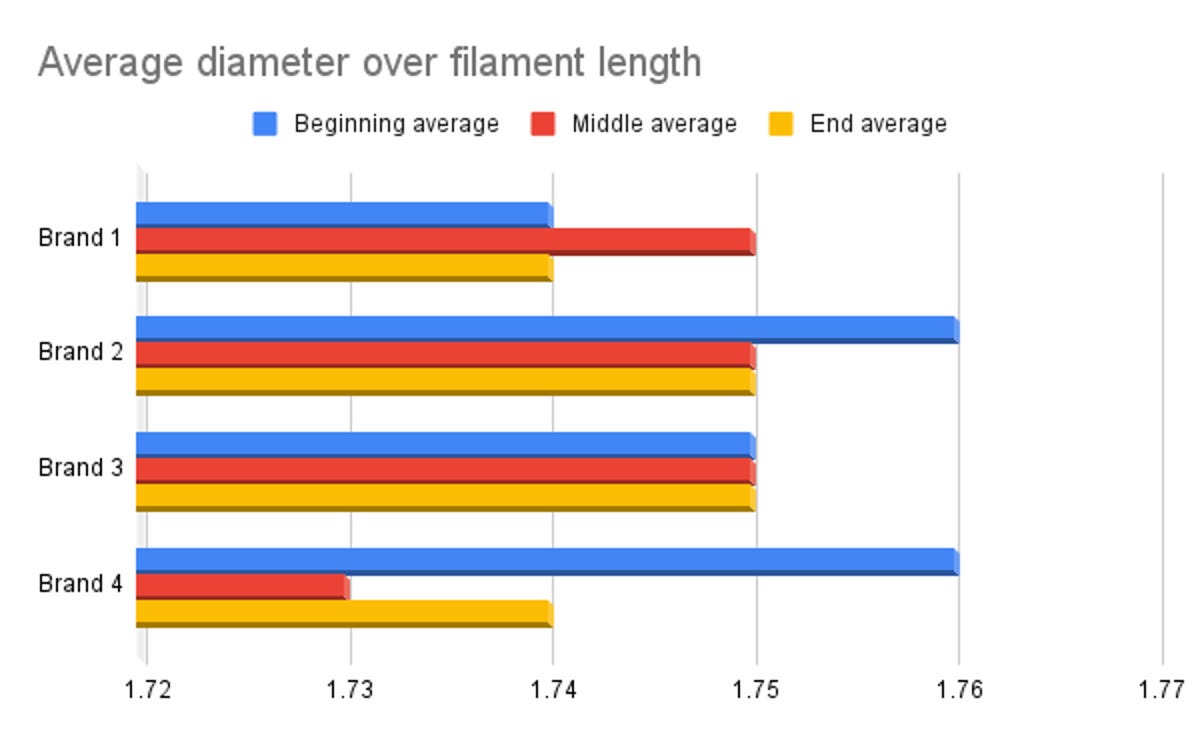

Dimensional accuracy is perhaps the most important test as it measures the consistency of filament. As you move along, the filament changes in diameter will cause the 3D printer to over- or under-extrude filament. This creates noticeable scarring in your model, or worse, complete failure. You want the material to have the same diameter the whole way through.
To measure the accuracy, I take a 5-meter piece of filament from the beginning, middle and end of the roll and measure the diameter at four equally spaced points. I then add all of those measurements up and divide the total by 12 — the total number of measurements taken — to give me an average across the roll. Most modern printers use 1.75mm filament so you want the filament to be as close to that as possible.
Great filament has a variance of +/- 0.02mm, good filament is +/- 0.03mm and rough filament is anything +/- 0.05mm. All of the filaments we have recommended here are at least 0.03mm on average.
More on 3D printing
Technologies
Apple Launches Creator Studio Package as $13 a Month Subscription
Mac users can still buy the apps individually, but subscribers get access to Final Cut Pro and other Studio tools.
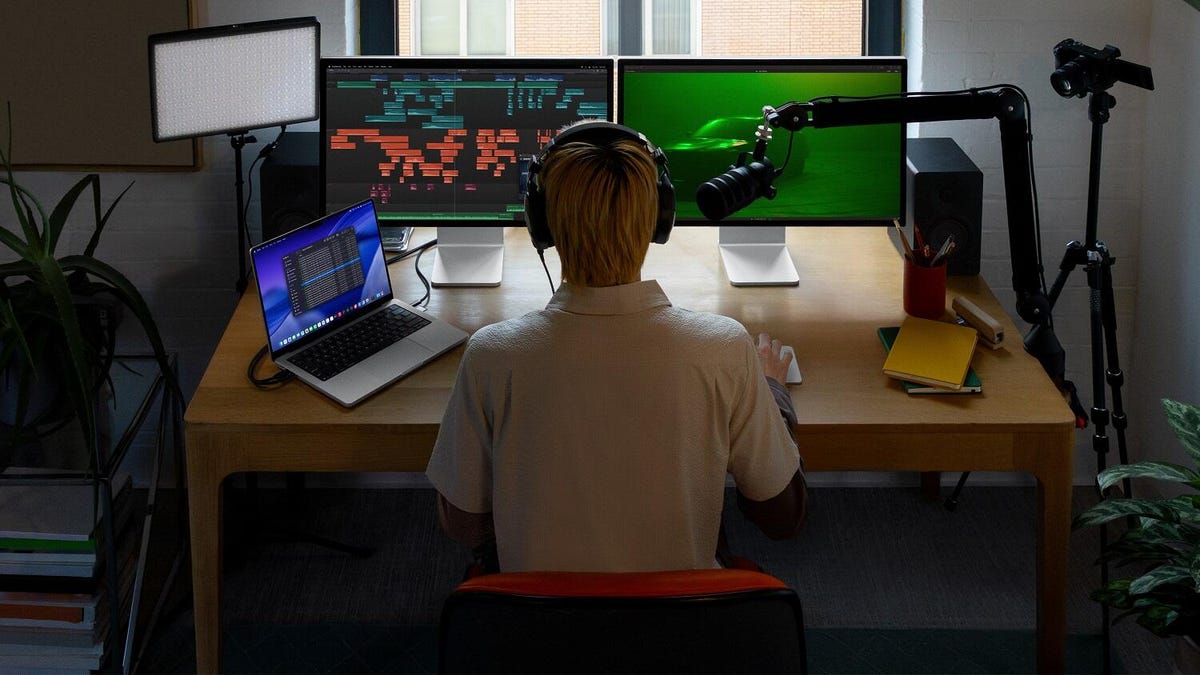
Apple is bundling its pro filmmaking and audio tools including Final Cut Pro with its productivity apps Keynote, Pages and Numbers into a subscription software suite called Apple Creator Studio.
The package, which includes apps for Mac, iPad and iPhone, includes Logic Pro, Pixelmator Pro, Motion, Compressor, MainStage and the whiteboard app Freeform. Creator Studio will be available starting Jan. 28 at a cost of $13 per month or $129 per year, or $3 per month or $30 per year for students and educators. Mac users will still have the option to purchase software like Final Cut Pro for a one-time free. The current price for Final Cut Pro in the Mac App Store is $300.
While apps such as Keynote and Pages are already free on Apple platforms, it appears that new versions of those apps will receive access to beta features that will roll out first to Creator Studio subscribers. The announcement by Apple alludes to «new AI features and premium content» in some of the apps it otherwise makes available to use for free.
What the Creator Studio bundle comes with
The star of the show in Creator Studio is Final Cut Pro, the video editing software that will now include Transcript Search on both Mac and iPad. There is also a new Beat Detection feature Apple says uses an AI model to analyze a music track and display a beat grid, making it easier to cut video to music rhythms. The software also will include a new Montage Maker on iPad for quick social video creation.
Motion, the 2D and 3D graphics tool, and Compressor also integrate with Final Cut Pro. Apple touted Motion’s Magnetic Mask feature for isolating objects or people without the need for a green screen.
Logic Pro has new features for musicians, including a Synth Player addition to AI Session Players. Chord ID, a new AI feature, can create chord progressions from audio or MIDI recordings. A new Sound Library will have hundreds of royalty-free clips, samples and loops.
A revamped MainStage app gives subscribers access to instrument, voice-professing and guitar rig tools. Pixelmator Pro arrives with new tools and filters, and there will be an iPad version in addition to the Mac tool.
Freeform in the Creator Studio package will add premium content, including curated photos, graphics and illustrations. It will also get new AI features that include image creation.
Technologies
Reddit Outage Resolved: Here’s What Happened
Did you have trouble reading your favorite subreddits today? You weren’t alone.
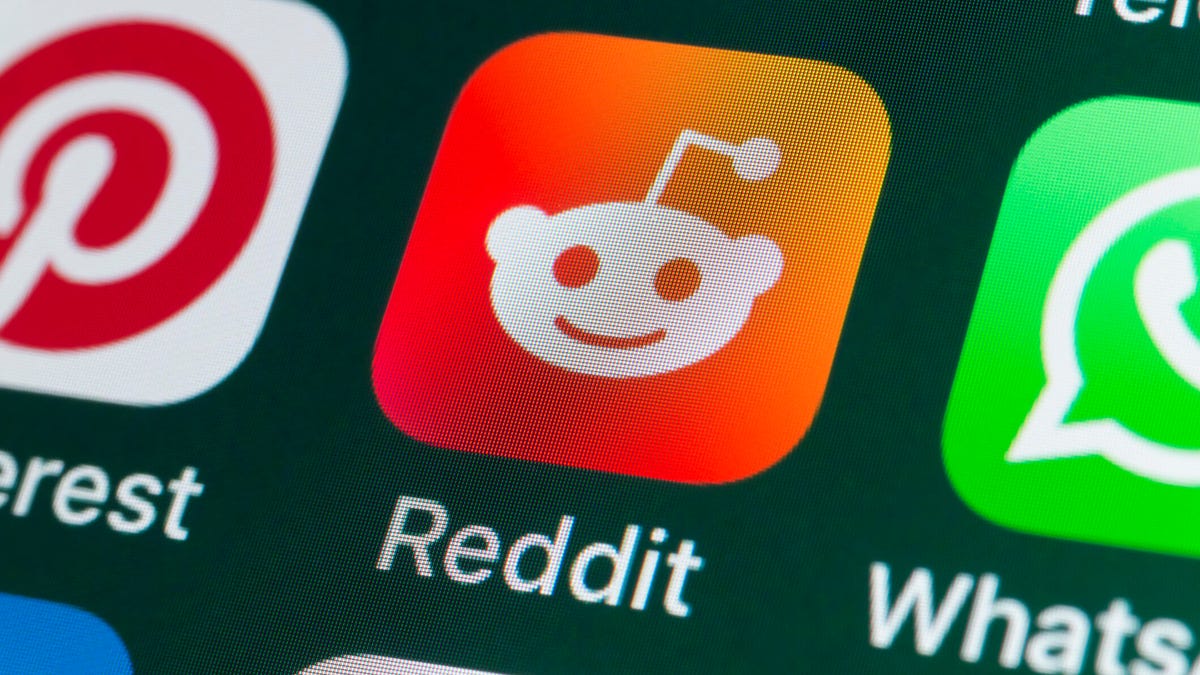
If you had trouble accessing the news and discussion forum Reddit on Tuesday, you weren’t the only one. However, as of 10:15 a.m. PT, the site appears to be back up and running normally. Reddit’s status monitoring page, RedditStatus.com, notes that «all systems (are) operational» after the brief outage.
But earlier, at 9:30 a.m. PT, RedditStatus.com said the company was «investigating elevated errors across reddit.com and native apps.» RedditStatus.com reported degraded site performance for both desktop web use and native mobile apps.
Earlier on Tuesday, the site-monitoring service DownDetector also reported issues at Reddit, providing additional details. At one point on Tuesday, DownDetector received over 100,000 reports that the site was having problems. At 10:25 am PT, the report numbers fell to under 600. (Disclosure: Downdetector is owned by the same parent company as CNET, Ziff Davis.)
Don’t miss any of our unbiased tech content and lab-based reviews. Add CNET as a preferred Google source.
«Reddit is currently experiencing a significant internal outage causing widespread service disruptions,» the site said earlier Tuesday. «The impact is categorized as Very High, primarily affecting mobile app access (55%) and website connectivity (39%). While reports are heavily concentrated in major hubs like New York City and Chicago, the lack of ISP correlation suggests a broad, nationwide issue stemming from Reddit’s internal servers rather than external network providers.»
A representative for Reddit did not immediately respond to a request for comment. Another social media site, X, formerly Twitter, also showed problems on Tuesday, according to DownDetector. Those problems seemed to spike around 6:30 a.m. PT and improve after.
Technologies
This 3-in-1 Charger Is a Must-Have for Travelers, and It Just Hit a Record-Low of $95
Snag it for $45 off and charge your iPhone, AirPods and Apple Watch at the same time.
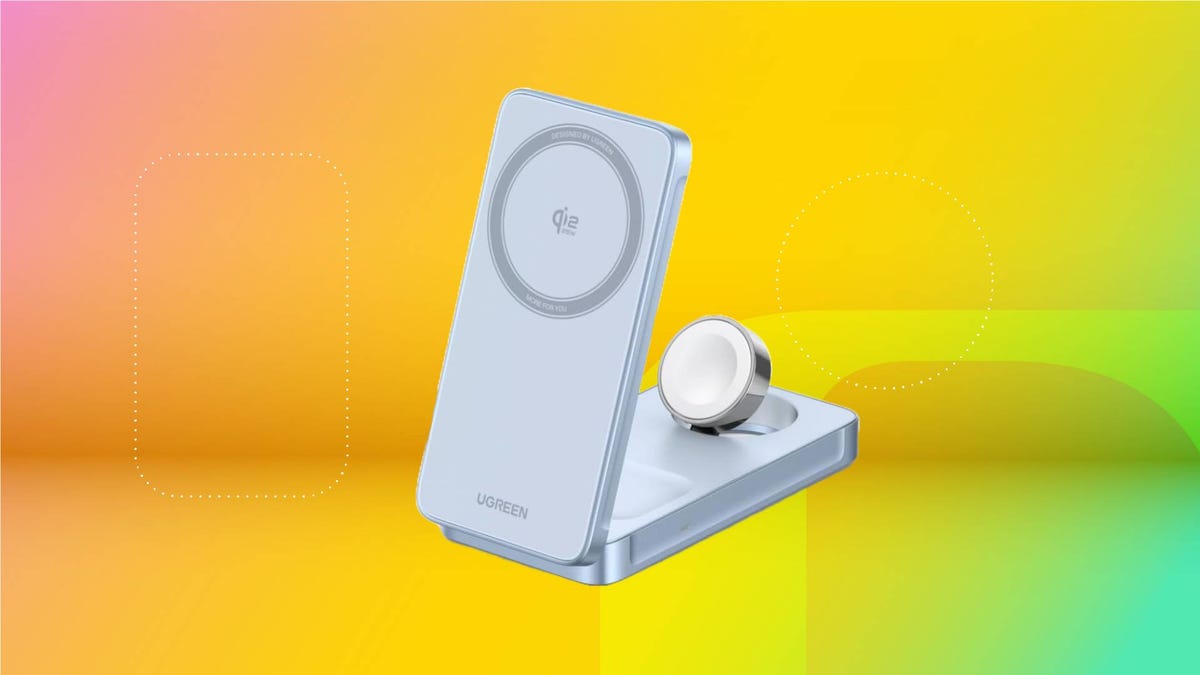
If you’re a frequent traveler, then you know that outlets are a precious commodity in places like airports and coffee shops. So why waste one on a single device when you can charge up to three at once? Right now, you can grab this seriously sleek Ugreen Magflow three-in-one foldable charger for just $95 at Amazon. That’s a $45 discount and the all-time lowest price we’ve seen. Just don’t wait too long, as this deal could expire at any time.
At just 7.4 ounces, this compact charging station is designed to be taken on the go. But despite its size, it still supports 25-watt MagSafe charging for iPhones, as well as 5-watt wireless charging for AirPods and Apple Watches. The charging stand also tilts up to double as a stand, and it’s equipped with 16 magnets to keep your phone aligned and securely in place. Plus, it’s got built-in protections against overheating, overcharging, short-circuiting and more to prevent damage to your devices.
Why this deal matters
This folding Ugreen charger is great for juicing up your devices on the go, and it’s never been more affordable. Plus, Ugreen makes some of the best MagSafe chargers on the market right now, so don’t miss your chance to grab one at a record-low price.
-

 Technologies3 года ago
Technologies3 года agoTech Companies Need to Be Held Accountable for Security, Experts Say
-

 Technologies3 года ago
Technologies3 года agoBest Handheld Game Console in 2023
-

 Technologies3 года ago
Technologies3 года agoTighten Up Your VR Game With the Best Head Straps for Quest 2
-

 Technologies4 года ago
Technologies4 года agoBlack Friday 2021: The best deals on TVs, headphones, kitchenware, and more
-

 Technologies4 года ago
Technologies4 года agoGoogle to require vaccinations as Silicon Valley rethinks return-to-office policies
-

 Technologies4 года ago
Technologies4 года agoVerum, Wickr and Threema: next generation secured messengers
-

 Technologies4 года ago
Technologies4 года agoOlivia Harlan Dekker for Verum Messenger
-

 Technologies4 года ago
Technologies4 года agoiPhone 13 event: How to watch Apple’s big announcement tomorrow

